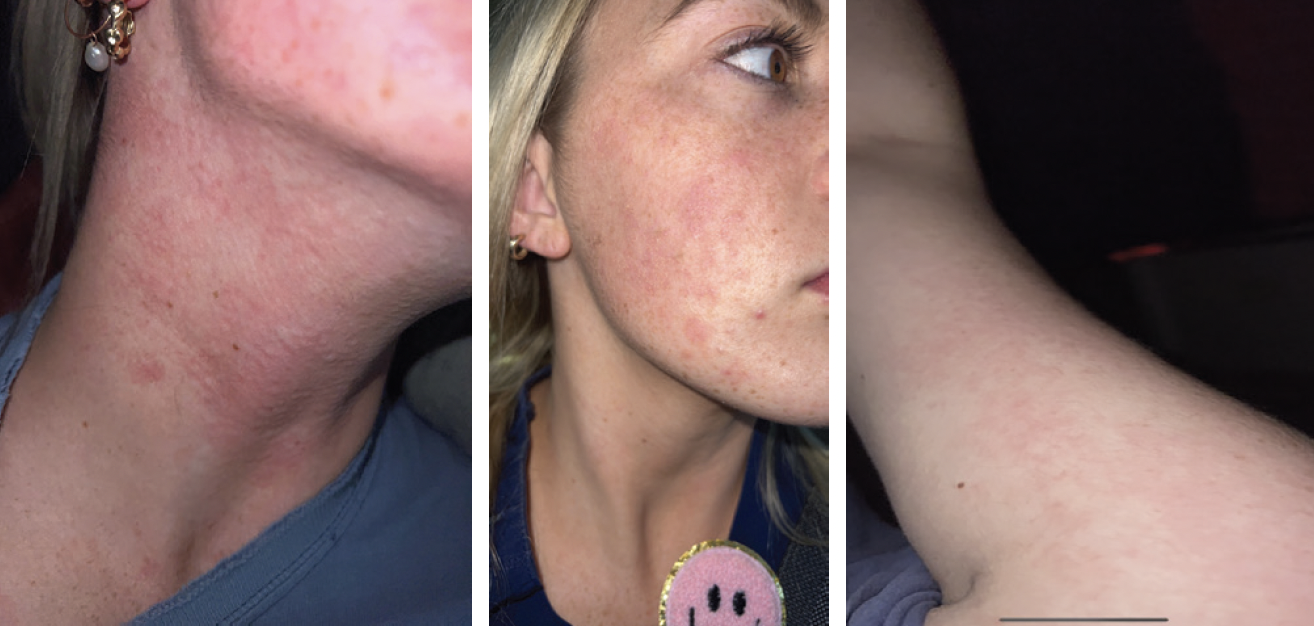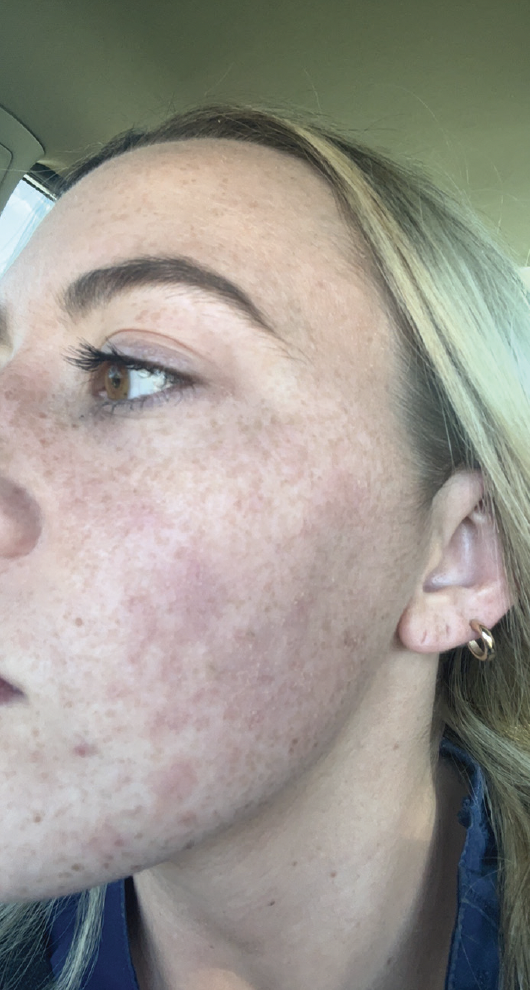Acute Contact Urticaria Due To Use of Cocamidopropyl Betaine-Containing Products Confirmed with Patch Testing
Case Presentation
A 23-year-old Caucasian woman presented with progressive worsening recurrent symptoms of hives, burning sensation, and pruritus located on the skin of the face, neck, and arms (see Fig 1, Fig 2). These symptoms began following the use of Biolage Matrix shampoo. She started taking antihistamines (loratadine 10 mg) 15-20 minutes prior to hair washing which minimized her symptoms. The patient then began to experience dry, pruritic patches all over her face after starting a new face wash product which then led to the need of antihistamines four times a day (see Fig 3.). The symptoms did not fully resolve until the use of the cleanser was stopped. The patient presented to clinic, and we presumed that her symptoms were attributable to delayed hypersensitivity to coconut oil. A patch of Cocamidopropyl betaine was placed to test for hypersensitivity to the ingredient. This ingredient is present in both her shampoo and face wash. Within 10 minutes of patch being placed she developed an intensely pruritic urticarial erythematous plaque at the patch placement site. We diagnosed her with contact urticaria, a type 1 hypersensitivity reaction to Cocamidopropyl betaine. Diagnosis of acute contact urticaria was therefore made. The patient was given oral antihistamines and prescribed two epinephrine pens.

Fig 1. Neck 5 minutes after application of Cocamidopropyl betaine containing shampoo (A), Face following use of Cocamidopropyl betaine containing shampoo (B), Arm following use of Cocamidopropyl betaine containing shampoo (C).

Fig 2. Face 5 minutes after application of Cocamidopropyl betaine containing shampoo.

Fig 3. Face 5 minutes after application of Cocamidopropyl betaine containing face wash.
Discussion
Cocamidopropyl betaine is a surfactant compound which includes an ammonium zwitterion and fatty acid amide. The ability to act as an amphoteric surfactant is employed in both cosmetic and personal care products.3 Cocamidopropyl betaine is often used frequently as a thickener, emulsifier, and foam booster in shampoos.5 Less common uses of the ingredient are seen in antiseptics. Some products with this ingredient are marketed in children’s products as “hypoallergenic” or “for sensitive skin” despite the skin reactions known to occur.2 The main source of sensitization and skin irritation is thought to arise from impurities formed during the manufacturing process of Cocamidopropyl betaine containing products which include amidoamine and dimethylaminopropylamine. In addition, studies have found Cocamidopropyl betaine rather than the impurities lead to the formation of a cutaneous delayed-hypersensitivity reaction as well.

What makes this case interesting to us is that the patient initially experienced a type IV, delayed hypersensitivity reaction that further progressed to a type I hypersensitivity IgE-mediated urticaria upon additional use of Cocamidopropyl betaine products. This is also the first time that any of the authors have appreciated an immediate contact urticaria with patch test placement. We felt it is important to highlight the differences between these two hypersensitivities and present her case.
Type 4 hypersensitivity reactions typically occur within 48-72 hours post exposure to chemicals, drugs, contact irritants, metals, and infectious agents. This reaction is an antibody-independent T-cell mediated immune response that involves recruitment of T-lymphocytes and macrophages into the tissues. An inflammatory response is mounted by the effector macrophages via the release of inflammatory mediators and enzymes leading to localized damage in the form of swelling, erythema, and potential papule formation.4 A common example is the development of contact dermatitis a few days after exposure to poison ivy. Since this hypersensitivity reaction is T-cell mediated, immune memory is present upon repeat exposure of the irritant mediated by CD4+ and CD8+ memory T-cells leading to a more rapid and effective immune response.
Type 1 hypersensitivity reactions contrast type 4 in several aspects. Beginning with onset of symptoms, which occurs minutes to hours post exposure via an IgE-mediated immune response. An initial sensitization occurs when an individual is first exposed to an allergen such as pollen, dusts, mites, or certain foods which in turn activates B-cells and leads to differentiation into plasma cells which produce specific IgE antibodies to the specific allergen. These specific IgE antibodies then bind to mast cells and basophils leading to degranulation which involves release of inflammatory mediators such as histamines and leukotrienes. The release of these mediators is what leads to the specific type 1 hypersensitivity symptoms which can include anaphylaxis, itching, hives, urticaria, etc.1 A similarity with type 4 exists, as there is also memory involved in a type 1 hypersensitivity however it is mediated via memory B cells that are generated during the initial sensitization.
Overall, in the case of this patient, it could be hypothesized that the initial type 4 hypersensitivity reaction that occurred upon exposure to Cocamidopropyl betaine could have indirectly led to the development of type 1 hypersensitivity contact urticaria in subsequent exposures due to the influence of memory T cells on B cells leading to the production if IgE antibodies specific to Cocamidopropyl betaine. This could explain the development of symptoms within 5 minutes of use of the shampoo and face wash in addition to the presence of IgE mediated urticaria within 10 minutes of skin patch testing.
Patient was diagnosed with Cocamidopropyl betaine allergy. No further treatment was initiated for the patient as avoidance of products containing Cocamidopropyl betaine prevented any additional skin reactions.
The authors report no relevant financial disclosures.
1. Abbas M, Moussa M, Akel H. Type I Hypersensitivity Reaction. [Updated 2023 Jul 17]. In: StatPearls [Internet]. Treasure Island (FL): StatPearls Publishing; 2023 Jan. Available from: https://www.ncbi.nlm.nih.gov/books/NBK560561/
2. Collis RW, Sheinbein DM. Cocamidopropyl betaine is commonly found in hypoallergenic personal care products for children. J Am Acad Dermatol. 2020;82(5):1245-1247. doi:10.1016/j.jaad.2019.12.036
3. Jacob SE, Amini S. Cocamidopropyl betaine. Dermatitis. 2008;19(3):157-160.
4. Marwa K, Kondamudi NP. Type IV Hypersensitivity Reaction. [Updated 2023 Aug 12]. In: StatPearls [Internet]. Treasure Island (FL): StatPearls Publishing; 2023 Jan. Available from: https://www.ncbi.nlm.nih.gov/books/NBK562228/
5. Shaughnessy CN, Malajian D, Belsito DV. Cutaneous delayed-type hypersensitivity in patients with atopic dermatitis: reactivity to surfactants. J Am Acad Dermatol. 2014;70(4):704-708. doi:10.1016/j.jaad.2013.12.009
Ready to Claim Your Credits?
You have attempts to pass this post-test. Take your time and review carefully before submitting.
Good luck!





